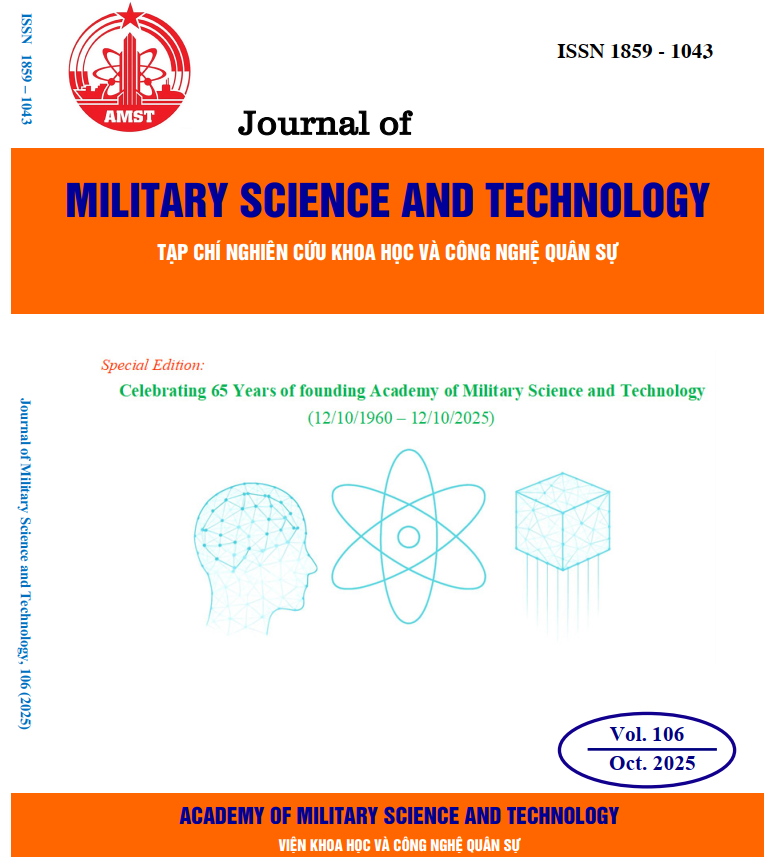Investigation of polyphenol derivative extraction from Terminalia catappa leaves and assessment of their corrosion inhibition performance on CB300 steel in saline solution
Keywords:
Terminalia catappa leaves; Polyphenol extraction; Corrosion inhibition; Seawater corrosion; Green inhibitor.Abstract
This research investigates the extraction of polyphenolic compounds from Terminalia catappa leaves and their application as a natural corrosion inhibitor for CB300 steel in saline solution. The parameters for key extraction, as solvent ratio, temperature, and extraction duration, were tuned to enhance polyphenol yield. The optimal conditions were identified as a 1:1 ethanol-water solvent ratio, extraction at 60 °C, and a heating duration of 30 minutes. The composition of the extract was analyzed using UV-Vis and FTIR spectroscopy, which confirmed the presence of polyphenolic functional groups. The effectiveness of preventing corrosion was measured using SEM, EDX, potentiodynamic polarization, and electrochemical impedance spectroscopy (EIS). The results indicated that the extract created a protective layer on the steel surface, diminishing corrosion activity. The corrosion rate was decreased by 42.39% relative to the control at an optimum concentration of 0.004% in a 3.5% NaCl solution. Nevertheless, elevated extract concentrations marginally reduced inhibitory efficacy owing to heightened acidity. This study illustrates the efficacy of the extract from Terminalia catappa leaves as a sustainable and environmentally friendly corrosion inhibitor for steel structures in marine settings.
References
[1]. Tran Duc Thanh, et al. "Biển đảo Việt Nam-Tài nguyên vị thế và những kỳ quan địa chất, sinh thái tiêu biểu", Publishing House of Natural Sciences and Technology, p. 9, (2012) (in Vietnamese).
[2]. S. A. Umoren, et al. "A Critical Review on the Recent Studies on Plant Biomaterials as Corrosion Inhibitors for Industrial Metals", Journal of Industrial and Engineering Chemistry, 76(25), pp. 91–115, (2019).
[3]. J. K. Das, et al. "Experimental investigation on inhibiting compounds against steel corrosion in concrete admixed with different chloride salts", Materials and Structures, 56(14), (2023).
[4]. M. C. Ienașcu, et al. "Some Brassicaceae Extracts as Potential Antioxidants and Green Corrosion Inhibitors", Materials, 16(8), (2023).
[5]. Q. Wang, et al. "Evaluation for Fatsia japonica leaves extract (FJLE) as green corrosion inhibitor for carbon steel in simulated concrete pore solutions", Journal of Building Engineering, 63, p. 105568, (2023).
[6]. R. Shanmugapriya, et al. "Electrochemical and Morphological investigations of Elettaria cardamomum pod extract as a green corrosion inhibitor for Mild steel corrosion in 1 N HCl", Inorganic Chemistry Communications, 154, p. 110958, (2023).
[7]. P. G. Waterman, et al. "Analysis of phenolic plant metabolites", Blackwell Scientific Publ., Oxford, (1994).
[8]. Trinh Xuan Sen. "Ăn mòn và bảo vệ kim loại", Hanoi National University Publishing House, pp. 149–153, (2006) (in Vietnamese).
[9]. Ebrahimi, et al. "Extraction of polyphenolic dyes from henna, pomegranate rind, and Pterocarya fraxinifolia for nylon 6 dyeing", Coloration Technology, 132(2), pp. 162–176, (2016).
[10]. N. V. Thuy, et al. "Ảnh hưởng của các điều kiện chiết tách đến hàm lượng polyphenol và flavonoid tổng của lá cây Mãng cầu xiêm (Annona muricata Linn.)", Journal of Science and Technology, 3(1), pp. 52–56, (2020) (in Vietnamese).
[11]. Q. V. Vuong, et al. "Optimizing conditions for the extraction of catechins from green tea using hot water", Journal of Separation Science, 34(21), pp. 3099–3106, (2011).
[12]. M. P. Casaletto, et al. "Inhibitor of cor-ten steel corrosion by 'green' extracts of Brassica campestris", Corrosion Science, 136, pp. 91–105, (2018).







